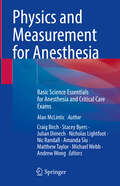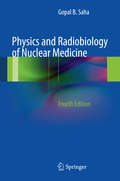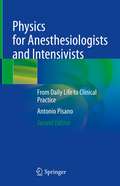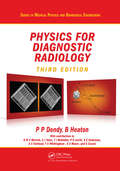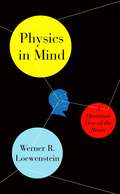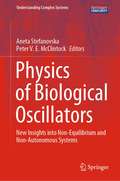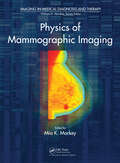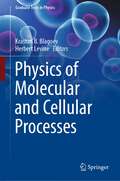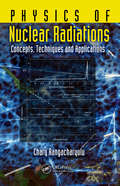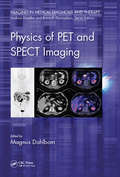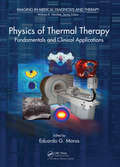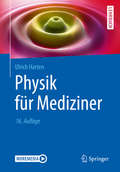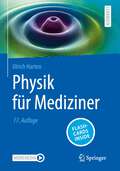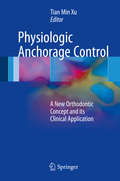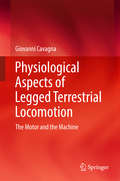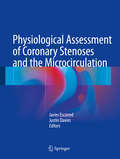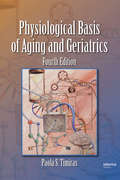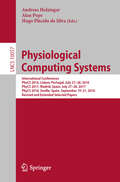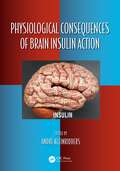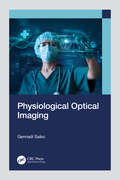- Table View
- List View
Physics MCQs for the Part 1 FRCR
by Tomasz Matys Nasim Sheikh-Bahaei Adam K. Yamamoto Shahzad Ilyas Martin J. Graves Shahzad Ilyas Tomasz Matys Nasim Sheikh-Bahaei Adam K. YamamotoPhysics MCQs for the Part 1 FRCR is a comprehensive and practical revision tool for the new format Part 1 FRCR examination, covering the complete physics curriculum. Key features: • Contains 300 questions that reflect the style and difficulty of the real exam • Covers basic physics, radiation legislation and all the imaging modalities included in the Royal College of Radiologists training curriculum and new FRCR examination • Includes new exam topics such as MRI and ultrasound imaging • Answers are accompanied by clear, detailed explanations giving candidates in-depth understanding of the topic • Much of the question material is based on the Radiology-Integrated Training Initiative (RITI), as recommended by the Royal College of Radiologists A must-have revision resource for all Part 1 FRCR candidates, Physics MCQs for the Part 1 FRCR is written by a team of specialist registrars who have recently successfully passed the Part 1 FRCR exam and a renowned medical physicist.
Physics and Measurement for Anesthesia: Basic Science Essentials for Anesthesia and Critical Care Exams
by Matthew Taylor Andrew Wong Michael Webb Craig Birch Stacey Byers Julian Dimech Nicholas Lightfoot Nic Randall Amanda SiuAnesthesia is a practical, clinically based medical science. Its conduct requires Anesthesiologists and Intensivists to learn and understand the principles of applied physics related to equipment responsible for the clinical care of patients. This book is written primarily for anesthetic registrars/residents and their teachers, to assist with preparation for the post graduate, basic science examinations in anesthesia and critical care medicine. Each topic is systematically covered using first principles, contextual examples, and illustrations to explain and demonstrate complex concepts. This comprehensive book is an up-to-date compilation of these scientific principles that can easily be applied to any operating theatre or intensive care unit around the world.
Physics and Radiobiology of Nuclear Medicine
by Gopal B. SahaThe Fourth Edition of Dr. Gopal B. Saha's Physics and Radiobiology of Nuclear Medicine was prompted by the need to provide up-to-date information to keep pace with the perpetual growth and improvement in the instrumentation and techniques employed in nuclear medicine since the last edition published in 2006. Like previous editions, the book is intended for radiology and nuclear medicine residents to prepare for the American Board of Nuclear Medicine, American Board of Radiology, and American Board of Science in Nuclear Medicine examinations, all of which require a strong physics background. Additionally, the book will serve as a textbook on nuclear medicine physics for nuclear medicine technologists taking the Nuclear Medicine Technology Certification Board examination. The Fourth Edition includes new or expanded sections and information for: * PET/MR, including the attenuation correction method and its quality control tests; * accreditation of nuclear medicine and PET facilities; * solid state digital cameras; * time of flight and scatter correction techniques; * CT scanners and attenuation correction in SPECT/CT; * partial volume effects; * quality control of CT scanners; * ion chamber survey meters, proportional counters, and G-M counters.
Physics for Anesthesiologists and Intensivists: From Daily Life to Clinical Practice
by Antonio PisanoThis book, now in its 2nd edition, discusses, explains and provides detailed, up-to-date information on physics applied to clinical practice in anesthesiology and critical care medicine, with the aid of simple examples from daily life. Almost everything that happens around us, including in the operating room and intensive care units, can be explained by physical laws. An awareness and understanding of relatively simple laws such as the Hagen-Poiseuille equation, or of slightly more complex topics such as harmonic motion and electromagnetism, to name just a few, offer anesthesiologists and intensivists fascinating insights into why they do what they do.After an introductory chapter that brushes up on all the (few) mathematics the reader will need to face the book, with many practical examples and clinical applications, each of the following 20 chapters deals with some everyday phenomena, explains them with one or more physical laws, and shows why these laws are important in anesthesia and critical care practice. Many illustrations are included for extra clarity. This enriched and updated edition of Physics for Anesthesiologists is intended for anesthesiologists, intensivists, anesthesia and intensive care medicine teachers and trainees, as well as medical students.
Physics for Diagnostic Radiology (Series in Medical Physics and Biomedical Engineering)
by Philip Palin Dendy Brian HeatonWith every chapter revised and updated, Physics for Diagnostic Radiology, Third Edition continues to emphasise the importance of physics education as a critical component of radiology training. This bestselling text helps readers understand how various imaging techniques work, from planar analogue and digital radiology to computed tomography (CT),
Physics for the Anaesthetic Viva
by Kalsi, Aman and Balani, Nikhail Aman Kalsi Nikhail BalaniPhysics for the Anaesthetic Viva is a succinct and practical text that comprehensively covers all aspects of the physics and clinical measurement curriculum for the FRCA examinations. Each section begins by explaining the basic science concepts, which are then expanded and related to everyday practice. Illustrations are used to enhance understanding of the concepts, and are presented in such a way as to be easy to reproduce in the exam setting. In addition, sample viva questions are provided at the end of each chapter to test learning, or for use in a mock viva session. Written by trainees for trainees, this book provides exactly what you need to pass the exam.
Physics in Mind: A Quantum View of the Brain
by Werner R. LoewensteinNo one can escape a sense of awe when reflecting on the workings of the mind: we see, we hear, we feel, we are aware of the world around us. But what is the mind? What do we mean when we say we are "aware” of something? What is this peculiar state in our heads, at once utterly familiar and bewilderingly mysterious, that we call awareness or consciousness? In Physics in Mind, eminent biophysicist Werner R. Loewenstein argues that to answer these questions, we must first understand the physical mechanisms that underlie the workings of the mind. And so begins an exhilarating journey along the sensory data stream of the brain, which shows how our most complex organ processes the vast amounts of information coming in through our senses to create a coherent, meaningful picture of the world. Bringing information theory to bear on recent advances in the neurosciences, Loewenstein reveals a web of immense computational power inside the brain. He introduces the revolutionary idea that quantum mechanics could be fundamental to how our minds almost instantaneously deal with staggering amounts of information, as in the case of the information streaming through our eyes. Combining cutting-edge research in neuroscience and physics, Loewenstein presents an ambitious hypothesis about the parallel processing of sensory information that is the heart, hub, and pivot of the cognitive brain. Wide-ranging and brimming with insight, Physics in Mind breaks new ground in our understanding of how the mind works.
Physics of Biological Oscillators: New Insights into Non-Equilibrium and Non-Autonomous Systems (Understanding Complex Systems)
by Aneta Stefanovska Peter V. E. McClintockThis book, based on a selection of invited presentations from a topical workshop, focusses on time-variable oscillations and their interactions. The problem is challenging, because the origin of the time variability is usually unknown. In mathematical terms, the oscillations are non-autonomous, reflecting the physics of open systems where the function of each oscillator is affected by its environment. Time-frequency analysis being essential, recent advances in this area, including wavelet phase coherence analysis and nonlinear mode decomposition, are discussed. Some applications to biology and physiology are described.Although the most important manifestation of time-variable oscillations is arguably in biology, they also crop up in, e.g. astrophysics, or for electrons on superfluid helium. The book brings together the research of the best international experts in seemingly very different disciplinary areas.
Physics of Mammographic Imaging (Imaging in Medical Diagnosis and Therapy)
by Mia K. MarkeyDue to the increasing number of digital mammograms and the advent of new kinds of three-dimensional x-ray and other forms of medical imaging, mammography is undergoing a dramatic change. To meet their responsibilities, medical physicists must constantly renew their knowledge of advances in medical imaging or radiation therapy, and must be prepared
Physics of Molecular and Cellular Processes (Graduate Texts in Physics)
by Krastan B. Blagoev Herbert LevineThis is a graduate-level introduction to quantitative concepts and methods in the science of living systems. It relies on a systems approach for understanding the physical principles operating in biology. Physical phenomena are treated at the appropriate spatio-temporal scale and phenomenological equations are used in order to reflect the system of interest. Biological details enter to the degree necessary for understanding specific processes, but in many cases the approach is not reductionist. This is in line with the approach taken by physics to many other complex systems.The book bridges the gap between graduate students’ general physics courses and research papers published in professional journals. It gives students the foundations needed for independent research in biological physics and for working in collaborations aimed at quantitative biology and biomedical research. Also included are modern mathematical and theoretical physics methods, giving the student a broad knowledge of tools that can shed light on the sophisticated mechanisms brought forth by evolution in biological systems. The content covers many aspects that have been the focus of active research over the past twenty years, reflecting the authors' experience as leading researchers and teachers in this field.
Physics of Nuclear Radiations: Concepts, Techniques and Applications
by Chary RangacharyuluThis text makes the physics of nuclear radiations accessible to students with a basic background in physics and mathematics. Rather than convince students one way or the other about the hazards of nuclear radiations, the text empowers them with tools to calculate and assess nuclear radiations and their impact. It discusses the meaning behind mathematical formulae as well as the areas in which the equations can be applied. Coverage includes archeology, health, and medical physics applications.
Physics of PET and SPECT Imaging (Imaging in Medical Diagnosis and Therapy)
by Magnus DahlbomPET and SPECT imaging has improved to such a level that they are opening up exciting new horizons in medical diagnosis and treatment. This book provides a complete introduction to fundamentals and the latest progress in the field, including an overview of new scintillator materials and innovations in photodetector development, as well as the latest system designs and image reconstruction algorithms. It begins with basics of PET and SPECT physics, followed by technology advances and computing methods, quantitative techniques, multimodality imaging, instrumentation, pre-clinical and clinical imaging applications.
Physics of Thermal Therapy: Fundamentals and Clinical Applications (Imaging in Medical Diagnosis and Therapy)
by Eduardo G. MorosThe field of thermal therapy has been growing tenaciously in the last few decades. The application of heat to living tissues, from mild hyperthermia to high-temperature thermal ablation, has produced a host of well-documented genetic, cellular, and physiological responses that are being researched intensely for medical applications, particularly fo
Physics, Pharmacology and Physiology for Anaesthetists
by Matthew E. Cross Emma PlunkettA key requirement of the primary and final FRCA examinations is a sound understanding of the basic sciences behind anaesthetic practice. It is important to be able to describe these principles clearly, particularly in the viva section of the examinations. This fully updated new edition of a key title in the field of anaesthesia provides all the important graphs, definitions and equations which may be covered in the examinations, together with clear and concise explanations of how to present them to the examiner and why they are important. Packed full of precise, clear diagrams with well structured explanations, and with all key definitions, derivations and statistics, this is an essential study aid for all FRCA examination candidates.
Physics, Pharmacology and Physiology for Anaesthetists
by Matthew E. Cross Emma V. E. Plunkett Tom E. Peck Matthew E. Cross Emma V. E. PlunkettThe FRCA examination relies in part on a sound understanding of the basic sciences (physics, physiology, pharmacology and statistics) behind anaesthetic practice. It is important to be able to describe these principles clearly, particularly in the viva section of the examination. This book provides the reader with all the important graphs, definitions and equations which may be covered in the examination, together with clear and concise explanations of how to present them to the examiner and why they are important. Particular attention is paid to teaching the reader how to draw the graphs. This is an aspect of the examination which can be overlooked but which, if done well, can create a much better impression in the viva situation. Packed full of precise, clear diagrams with well structured explanations, and with all key definitions, derivations and statistics, this is an essential study aid for all FRCA examination candidates.
Physik für Mediziner
by Ulrich HartenFür den Durchblick in der Physik!Eine einfache, klare Sprache, viele Beispiele und zahlreiche Abbildungen – das und noch mehr sorgt für Aha-Effekte in der Physik und macht dieses Lehrbuch so erfolgreich. Egal ob Mechanik, Optik oder Elektrizitätslehre, hier erfährt man die Grundlagen zum weiteren Verständnis in der Medizin. Dabei helfen Ihnen:Videos über die kostenlose MoreMediaAppViele Beispiele für den PraxisbezugHervorhebung von beliebten PrüfungsthemenVerständnisfragen und Übungsaufgaben für die PrüfungsvorbereitungExtra Boxen für die Vorbereitung auf das Praktikum
Physik für Mediziner
by Ulrich HartenFür den Durchblick in der Physik! Eine einfache, klare Sprache, viele Beispiele und zahlreiche Abbildungen – das und noch mehr sorgt für Aha-Effekte in der Physik und macht dieses Lehrbuch so erfolgreich. Egal ob Mechanik, Optik oder Elektrizitätslehre, hier erfährt man die Grundlagen zum weiteren Verständnis in der Medizin. Dabei helfen Ihnen: Videos über die kostenlose MoreMediaAppViele Beispiele für den PraxisbezugHervorhebung von beliebten Prüfungsthemen Flashcards im Internet und Übungsaufgaben für die Prüfungsvorbereitung Extra Boxen für die Vorbereitung auf das Praktikum
Physiologic Anchorage Control
by Tian Min XuThis book provides a comprehensive introduction to physiologic anchorage control, explains the implications for clinical practice, and presents an anchorage technique applicable for the treatment of different malocclusions. The concept of physiologic anchorage control is derived from observations of upper molar movement during growth in adolescence, including in the absence of orthodontic treatment, which indicate that molar forward displacement comprises two components: the first due to biologic force or physiologic anchorage loss and the second due to orthodontic force or mechanical anchorage loss. All previous anchorage methods have been based on the assumption that molar anchorage loss is to be attributed solely to the mechanical force used to retract anterior teeth, and the new concept represents a paradigm shift of clinical significance. This book explores the pattern of upper molar growth in depth, highlights the physiologic significance of the curve of Spee, and analyzes the biomechanics of physiologic anchorage control. An anchorage control system that fully takes into account the latest conceptual insights is described and its clinical use and utility, examined.
Physiological Aspects of Legged Terrestrial Locomotion
by Giovanni CavagnaThis book offers a succinct but comprehensive description of the mechanics of muscle contraction and legged terrestrial locomotion. It describes on the one hand how the fundamental properties of muscle tissue affect the mechanics of locomotion, and on the other, how the mechanics of locomotion modify the mechanism of muscle operation under different conditions. Further, the book reports on the design and results of experiments conducted with two goals. The first was to describe the physiological function of muscle tissue (which may be considered as the "motor") contracting at a constant length, during shortening, during lengthening, and under a condition that occurs most frequently in the back-and-forth movement of the limbs during locomotion, namely the stretch-shortening cycle of the active muscle. The second objective was to analyze the interaction between the motor and the "machine" (the skeletal lever system) during walking and running in different scenarios with respect to speed, step frequency, body mass, gravity, age, and pathological gait. The book will be of considerable interest to physiology, biology and physics students, and provides researchers with stimuli for further experimental and analytical work.
Physiological Assessment of Coronary Stenoses and the Microcirculation
by Justin Davies Javier EscanedSince the introduction of coronary angiography, a key technique in understanding coronary artery disease, a number of paradigms regarding its study and interpretation have taken place. Following an emphasis on improved angiographic and subsequent intracoronary imaging techniques, functional assessment of coronary circulation has demonstrated to have major implications for diagnosis and treatment of coronary artery disease. Fractional flow reserve, a pressure derived index of stenosis severity, constitutes the best example of the current importance of physiological assessment in clinical practice. However, the acceptance of FFR by cardiologists contrasts with important voids in knowledge on the basic principles of coronary physiology and of other available techniques that, as an alternative to FFR, allow a more comprehensive assessment of coronary circulation. This is particularly noticeable in the assessment of microcirculation, an unavoidable compartment of coronary circulation that is frequently affected in acute coronary syndromes of in the presence of cardiovascular risk factors or non-coronary heart disease. A deeper understanding of the relationship between epicardial vessel and microcirculatory involvement has started with the advent of newer imaging techniques like invasive optical coherence tomography, and non-invasive CT and NMR techniques. This book aims to be an indispensable tool for clinicians and researches in the field of coronary artery disease. It provides a balanced, comprehensive review of anatomy, physiology and available techniques, discusses both the diagnosis of epicardial vessel and microcirculatory disease, the impact of different diseases at different levels of coronary circulation, and the best way to address a separate or combined assessment of different levels of coronary circulation.
Physiological Basis of Aging and Geriatrics
by Paola S. TimirasExtensively revised and updated to reflect the current state of knowledge in the study of aging, this Fourth Edition offers a complete profile of the aging process at all levels, from molecules and cells to demography and evolution. Written by international experts in current basic and clinical aging research, this text includes aspects of individual, comparative, and differential aging, and discussions of theories and mechanisms of aging. This invaluable reference illustrates how bodily systems, organs, and functions are affected with aging, describes how genetic and environmental factors influence age-related changes, and addresses some of the clinical consequences of these changes for health and longevity. Well illustrated, with numerous tables and graphs, this book presents up-to-date information from internationally renowned experts in various bio-medical fields.
Physiological Basis of Aging and Geriatrics (Fourth Edition)
by Paola S. TimirasThis Fourth Edition offers a complete profile of the aging process at all levels, from molecules and cells to demography and evolution. The text includes aspects of individual, comparative, and differential aging, and discussions of theories and mechanisms of aging.
Physiological Computing Systems: International Conferences, PhyCS 2016, Lisbon, Portugal, July 27–28, 2016, PhyCS 2017, Madrid, Spain, July 27–28, 2017, PhyCS 2018, Seville, Spain, September 19–21, 2018, Revised and Extended Selected Papers (Lecture Notes in Computer Science #10057)
by Andreas Holzinger Hugo Plácido da Silva Alan PopeThis book constitutes the proceedings of the Third International Conference on Physiological Computing Systems, PhyCS 2016, held in Lisbon, Portugal, in July 2016.The 12 papers presented in this volume were carefully reviewed and selected from numerous submissions. They contribute to the understanding of relevant trends of current research on physiological computing systems, including brain-computer interfaces, virtual reality, psychophysiological load assessment in unconstrained scenarios, body tracking and movement pattern recognition, emotion recognition, machine learning applied to diabetes and hypertension, tangible biofeedback technologies, multimodal sensor data fusion, and deep learning for hand gesture recognition.
Physiological Consequences of Brain Insulin Action (Oxidative Stress and Disease #50)
by André KleinriddersThe brain is crucial for the regulation of whole-body metabolism and behavior. The pancreas-derived hormone insulin modulates brain function and affects energy metabolism as well as cognition. This is partially achieved by modulating several types of brain cell populations including those relevant to satiety and reward. Importantly, brains of Alzheimer´s disease patients exhibit a signature of brain insulin resistance with perturbed brain metabolism. This book will cover the basics of insulin signaling in the brain and will describe concepts of insulin resistance, a feature of type 2 diabetes. Moreover insulin´s effect on cognitive function will be pointed out and the association between brain insulin resistance and neurodegenerative diseases discussed. Additionally, potential behavioral and pharmacological concepts which can affect brain insulin signaling will be summarized. Key Features: Summarizes insulin and the closely related IGF-1 receptor signaling Depicts concepts of insulin resistance Highlights the importance of conserved brain insulin signaling for brain function, metabolism, and behavior Describes potential behavioral and pharmacological approaches to support brain insulin signaling
Physiological Optical Imaging
by Gennadi SaikoPhysiological optical imaging is a group of emerging technologies that aim to provide healthcare practitioners and biomedical researchers with information about tissue physiology or pathophysiology using approaches different from traditional medical imaging (PET, ultrasound, MRI, X-ray, or CT scan).This book provides a comprehensive review of this group of technologies, combining a current medical literature review with an overview of cutting-edge technologies, the physics behind them, and common features across different technologies. It presents technical and physiological considerations that impact the sensitivity and spatial resolution of each technology and practical ways to improve them. The book emphasises low-cost technologies, which can be implemented in point-of-care settings. It is illustrated primarily with examples from wound care and oncology, with additional examples from other medical fields, including ophthalmology and neuroimaging.It can be used as a one-stop reference and practical guide for healthcare professionals, clinical researchers, and engineers working with emerging bioimaging technologies who are looking to utilise physiological optical imaging technologies in biomedical research or clinical practice.Key Features: Provides a comprehensive review of current technologies. Written as a practical guide with physiological and design considerations and illustrations. Presents a 360-degree view on the topic: a combination of clinical information alongside a technological background.

